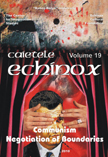The Romanian or the Moldavian Language? Language as an artificial boundary among the inhabitants of a new state
The Romanian or the Moldavian Language? Language as an artificial boundary among the inhabitants of a new state
Author(s): Alin RusSubject(s): Anthropology
Published by: Universitatea Babeş-Bolyai
Keywords: Eastern Europe; Communist Heritage; Ideology of Boundaries; Language Politics; Moldavian Language; Romanian Language.
Summary/Abstract: This article briefly discusses the idea of boundary as it appears in the history of anthropology and focuses as a case study on the ex-soviet Republic called Moldavia and its language after the collapse of the Soviet Union and the creation of a new state: Moldavia Republic. Using the tools and methods of Cultural Anthropology I will show how, in Moldavia Republic the traces of the artificial boundaries drawn during Soviet times are still visible today. One of these boundaries is the artificial distinction between Moldavian and Romanian language as two separate languages and between Moldavian people and Romanian people as two separate ethnic groups. My main argument in this article is that the very long and convoluted discourse focusing on language politics in a new state, the Moldavian Republic, is a consequence of the artificial boundaries that were imposed in all the aspects of the public life during Soviet time.
Journal: Caietele Echinox
- Issue Year: 2010
- Issue No: 19
- Page Range: 362-373
- Page Count: 12
- Language: English
- Content File-PDF

